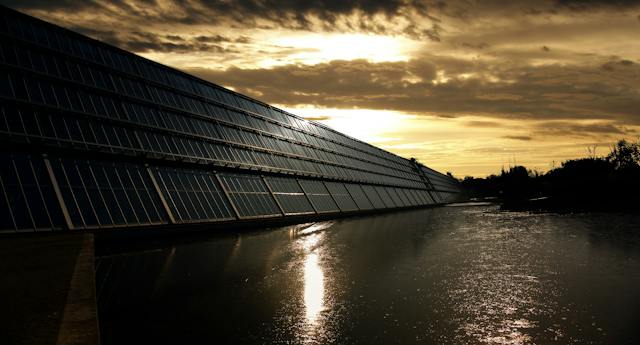
Urban living has witnessed a notable transformation in recent years. What started with sustainable, energy-efficient homes has now informed urban development. Cities are no longer just concrete jungles; they are evolving into intelligent hubs that harness the power of the sun to fuel progress. Where innovation meets sustainability, solar power is paving the way for smart cities.
In this exploration, we’ll unravel the dynamic synergy between solar energy and smart technologies. We’ll uncover how this tandem is reshaping our cities for a brighter, more sustainable tomorrow and smarter, greener urban landscapes.
The Intersection of Solar Power and Smart Technology
Indeed, the intersection of solar power and smart technology marks a revolutionary shift in how we harness and manage energy. With the Internet of Things (IoT), we’re witnessing a paradigm where solar energy management becomes incredibly efficient. Through smart grids and advanced solar power distribution systems, cities can optimize energy consumption on a granular level, responding dynamically to demand.
Data analytics is pivotal in this transformation, enabling us to scrutinize energy consumption patterns. By analyzing this data, cities can implement more effective solar infrastructure maintenance strategies, ensuring longevity and reliability. From solar-powered parking lot lights to street lights, ample cities are now achieving remarkable energy efficiency.
But it doesn’t stop there; solar power propels transportation into a new era. Solar-powered vehicles and charging stations are becoming commonplace, offering a clean and sustainable alternative to traditional transportation. Furthermore, integrating solar panels in public transportation further reduces reliance on conventional energy sources. This amalgamation of solar power and smart technology opens doors to comprehensively reimagining how cities function and evolve.

From city infrastructure and transportation to natural landscapes, solar power is offering a brighter way forward.
Economic and Social Impacts of Solar-Powered Smart Cities
In turn, this intersection brings forth an array of advantages. As solar power is paving the way for smart cities, it’s also paving the way to a prosperous future. Beyond the ample environmental benefits it brings, economic and social ones also warrant noting.
Job Creation and Economic Growth
For one, solar-powered smart cities act as a catalyst for job creation and robust economic growth. The rise of solar power fuels employment opportunities, particularly in the renewable energy sector. From manufacturing and installation to maintenance and research, a thriving job market emerges, offering diverse roles for individuals. This not only addresses unemployment concerns but also contributes to a skilled workforce.
Furthermore, the economic benefits ripple through reduced energy costs. As cities transition to solar power, they witness substantial savings in energy expenditures. Businesses and households alike benefit from lower utility bills, freeing up resources that can be redirected toward other economic activities.
The cumulative effect is a dynamic cycle of job creation, increased disposable income, and overall economic growth. As such, the adoption of solar power emerges as a strategic economic choice with far-reaching positive implications for communities and their prosperity.
Enhanced Quality of Life
In addition, solar-powered smart cities bring about a profound social impact by enhancing the quality of life for diverse communities. Crucially, these advancements in sustainable energy ensure that even underprivileged communities gain access to renewable energy sources. This fosters inclusivity and empowers individuals with a more reliable and affordable energy supply.
Additionally, the positive effects extend to public health and air quality. Improved air quality is particularly crucial for vulnerable populations. As cities transition to solar power, reducing reliance on fossil fuels decreases air pollution, promoting healthier living conditions.
To illustrate the importance of air quality, we may observe how individuals and communities increasingly consider environmental factors when choosing where to live. Relocating to areas with superior air quality that enables healthier lifestyles is an emerging trend. Websites that review movers and relocation services, like Verified Movers Reviews, play a pivotal role in this decision-making process, providing valuable insights into companies that are capable of helping people move to regions with sustainable infrastructure. What’s more, these platforms offer individuals a chance to look into various moving companies, in hopes of finding the one that shares their eco-conscious values.

Greener, more sustainable cities are increasingly becoming popular relocation destinations due to their quality of life.
How Solar Power Is Paving the Way for Smart Cities
With all fundamentals in order, we can explore this synergistic intersection in due depth here.
Creating Sustainable Urban Environments
First, integrating solar power in smart cities is championing the creation of sustainable urban environments. As these cities adopt solar energy, they actively contribute to mitigating the adverse effects of climate change in urban areas. Solar power serves as a clean, renewable energy source, significantly reducing the carbon footprint associated with traditional energy generation methods.
This shift towards sustainability extends beyond just addressing environmental concerns; it’s about balancing energy demands with eco-friendly solutions. Solar power allows cities to meet their growing energy needs without compromising the well-being of the planet. By harnessing the sun’s energy, smart cities ensure a continuous and reliable power supply and set a precedent for environmentally responsible urban development. This transformative approach aligns with global efforts to combat climate change by nature. As it does, it also exemplifies how smart cities, powered by solar energy, can lead the charge.
Community Engagement and Education
Second, solar power’s impact on smart cities goes beyond infrastructure; it actively involves communities through education and engagement initiatives. Public awareness programs play a crucial role in educating residents about the benefits of solar energy. These programs inform individuals about the environmental advantages of solar power and inspire community participation in renewable energy initiatives. This inclusive approach fosters a sense of shared responsibility and ownership in the transition towards sustainable energy practices.
Moreover, school programs and curricula are pivotal in shaping the future. By integrating solar education into school syllabi, cities ensure that the younger generation is well-versed in the importance of sustainable energy. This raises awareness and contributes to a broader goal of promoting STEM education related to sustainable energy. Through community investment, engagement, and education, solar power is not just illuminating streets. It enlightens minds, paving the way for smarter, more environmentally conscious cities.

Through community investment and engagement, solar power is paving the way for smart cities in profound ways.
Empowering Cities for the Future
Lastly, solar power plays a transformative role in smart cities, empowering them for a future of sustainability and resilience.
One key aspect is enabling cities to become self-sufficient in energy production. By harnessing the abundant power of the sun, cities can generate a significant portion of their energy needs locally. As such, they reduce dependence on external sources and enhance energy security. This shift ensures a stable and reliable energy supply and contributes to the overall sustainability of urban environments.
Furthermore, solar power fosters innovation and technological advancements. The integration of solar technologies prompts cities to explore innovative energy storage, distribution, and consumption solutions. This drive towards technological progress enhances the efficiency of solar energy utilization.
Finally, this drive also stimulates broader innovation in various sectors. As cities become hubs for renewable energy innovation, they position themselves at the forefront of the future. As sustainable practices and advanced technologies merge to create smarter, more resilient urban landscapes, solar-powered smart cities stand ready.
In essence, solar power is not just illuminating the present. It’s empowering cities to shape a future of energy independence, innovation, and a commitment to a sustainable and eco-friendly existence.
Conclusion
In closing, solar power is paving the way for smart cities in profound and highly beneficial ways. Through the synergy of solar energy and smart technologies, we’re witnessing a dynamic transformation in urban living. The benefits become undeniable, from mitigating the impacts of climate change to fostering economic growth and community engagement. As we embrace this shift towards clean, renewable energy, we’re brightening urban development prospects. This journey is a collective endeavor, one that holds the promise of a brighter, greener tomorrow for all of us.





There are no comments yet